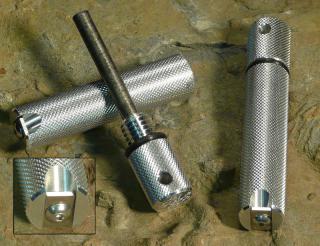Sunday, August 19 2012
Lightweight and designed for outdoor adventurers and anyone who likes to be prepared, Aurora Fire Starters will start a lifetime of campfires and are considered the best all-around survival fire starter in the world! Two models are now available and are perfect for prospectors who also camp while in the field. The 440C model is equipped with a stainless steel striking blade made from fully hardened 440C stainless steel that can be flipped over to reveal a fresh striking surface or be sharpened after prolonged use.
The 2SA model is equipped with a tungsten carbide (super alloy) striking blade that will never dull and will give even better sparks because it is one of the hardest materials on earth. The super alloy striking blade can also be used to sharpen knives in the field. The super alloy blade was designed for military personnel and is the best fire starter out there— as validated by the Navy Diver Olympics and the 2SA has even been up Mt. Everest! Monday, August 06 2012
Do you have a website, blog, or forum that caters to gold prospectors, metal detectorists, treasure hunters, or rockhounds located in the USA? Would you like the opportunity to earn an 8% commission on all sales you refer to our website? If so, we invite you to join the Gold Rush Trad ing Post Affiliate Program!
How It Works We use a trusted third party affiliate solutions provider (Shareasale.com) to track referred sales, calculate commissions on those sales, and send out commission checks. Once you complete your affiliate application with Shareasale.com and are approved (it's free to sign up), you will be provided with a unique ID and tracking links that tell our system whenever you refer a visitor. If that visitor decides to make a purchase within 60 days of clicking your link, you earn 8% of the purchase price (excluding shipping). Tracking, reporting and payments are handled by Shareasale, and your affiliate account will include up-to-date earnings reports and stats. Program Details
Friday, July 13 2012
It's summer, and that probably means you'll be vacationing or playing near water this month. Whether you're heading to a local lake or to an ocean across the country, take your metal detector. Beach hunting is fun and easy, and usually the finds are, well, pretty fine! Recovering an object from sand is pretty easy, too, especially compared to digging in hard ground. A sand scoop makes target recovery fast and easy.
Water and sunscreen have a sneaky way of slipping rings from fingers of swimmers and sunbathers, making beaches a lucrative location for metal detecting. Necklaces, watches, and bracelets are also great finds on beaches, along with coins— lots of coins. Although some beaches can yield historic artifacts, most finds will likely be of the modern variety. Some detectorists will argue that the best time to find goodies on a beach is after winter storms. While that’s certainly true, summer crowds can mean a fresh crop of coinage and jewelry just waiting to be found by you. Beach hunting can be done in dry sand or out in the water where many more rings are lost. Salt water beaches present special problems (mineralization) and you must determine if you will hunt only in dry sand, dip the coil under water in the shallows, or desire a totally submersible metal detector suitable for deep water wading or diving. All quality metal detectors have submersible search coils but not all control boxes are waterproof or suitable for the pressures of deep water diving, so match your detector to the type of detecting you’ll do. In all types of beach hunting, the discrimination must be kept very low, eliminating only small iron (bobby pins and nails). Aluminum pull tabs and tin foil should not be discriminated or gold and/or platinum rings may not be detected. Some beach hunters operate with zero discrimination and dig everything. Article continued here... Sunday, June 24 2012
The words "concentric" and "DD" (or "double-D") refer to the type of your metal detector's internal coil construction. Most searchcoils (whether round or elliptical) are of concentric construction. A concentric searchcoil has a large transmitter coil, and a smaller receiver coil in the center, usually in the same plane. This coil arrangement is relatively easy to manufacture and its symmetry helps to minimize electrical drift due to time and temperature. It also provides good discrimination on shallow targets.
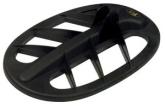 Some searchcoils (whether round or elliptical) are of DD construction. Double-D's comprise two overlapping D-shaped coils of approximately the same size, one being the transmitter and the other the receiver. The advantages of the DD are greater depth in mineralized soil, a broad sweep pattern, and narrower target response. Its primary disadvantages from a user's point of view are multiple responses on shallow targets and poor discrimination of flat iron objects. Designing and manufacturing them is more difficult because their lack of radial symmetry makes them prone to drift which the design and the manufacturing process must minimize. Manufacturing cost is higher because the coils cannot be wound on high-speed winding equipment. Some searchcoils (whether round or elliptical) are of DD construction. Double-D's comprise two overlapping D-shaped coils of approximately the same size, one being the transmitter and the other the receiver. The advantages of the DD are greater depth in mineralized soil, a broad sweep pattern, and narrower target response. Its primary disadvantages from a user's point of view are multiple responses on shallow targets and poor discrimination of flat iron objects. Designing and manufacturing them is more difficult because their lack of radial symmetry makes them prone to drift which the design and the manufacturing process must minimize. Manufacturing cost is higher because the coils cannot be wound on high-speed winding equipment.Double-D's are usually preferred for relic hunting and gold prospecting. Concentrics are usually preferred when searching for modern coins in an area where there is also iron and aluminum trash. Read more about searchcoils here... Friday, June 01 2012
A highbanker is basically a sluice box with mobility and added height. It is mounted on a 4-legged stand that gives the sluice box the correct slope. Instead of being put right in the creek like a sluice, an engine with a water pump and some hoses transports the water up from the stream into the highbanker. Highbankers are also called power sluices. It is a self-contained unit with many uses— prospecting, sampling, and concentrate clean up.
In general, a highbanker or power sluice is 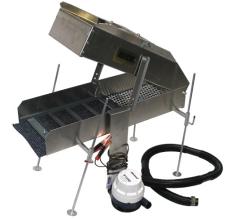 extremely efficient at trapping gold, including very fine or "flour" gold. The biggest benefit of having this piece of gold prospecting equipment is the ability to process gold-bearing gravels located a distance away from a water source— in other words, you get to bring the water to the gravel, not the gravel to the water! You can purchase a highbanker with a pump/motor and all hoses and fittings included, or you can buy those items separately. extremely efficient at trapping gold, including very fine or "flour" gold. The biggest benefit of having this piece of gold prospecting equipment is the ability to process gold-bearing gravels located a distance away from a water source— in other words, you get to bring the water to the gravel, not the gravel to the water! You can purchase a highbanker with a pump/motor and all hoses and fittings included, or you can buy those items separately.To run a highbanker, you need a system to pump water to it. Highbanker pumps can be either electric (12 volt battery) or gas driven. Some highbankers are also designed and constructed to re-circulate water so they can be employed in situations where little water is available. Keep in mind that the pumps deliver less water as your equipment location is moved uphill. Pumping uphill increases the resistance on the pump, and as you move uphill, eventually there is a point where the pump will not provide sufficient water to run the high banker. The slope on the highbanker usually ranges from about three to four inches per foot. Article continued here... Tuesday, May 15 2012
Following the discovery of gold in Coloma, California on January 24, 1848, boomtowns sprang up quicker than weeds. Just eight miles away, Old Dry Diggins was one such tent-filled mining camp that took root. So named because miners had to move cartloads of dry soil to running water in order to separate out the gold, the population quickly swelled from hundreds of gold seekers to thousands.
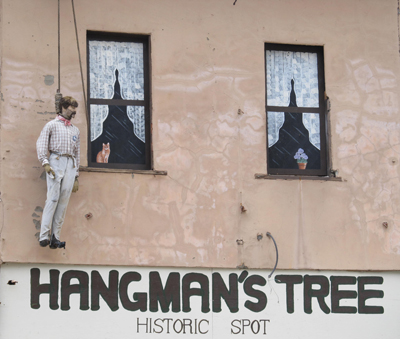 As to be expected, things got a little lawless and wild, and the name changed to Hangtown after numerous hangings took place in quick succession. Today, we know this historic gold rush town as Placerville, which has been the El Dorado county seat for the last 155 years. 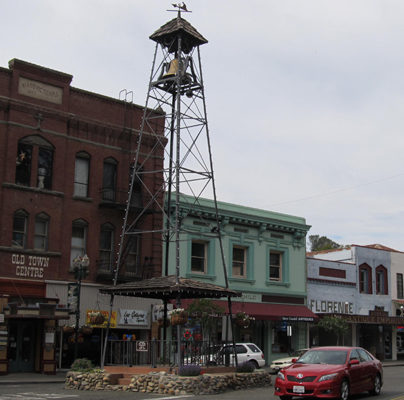 Over the years, Placerville has lost many of its old buildings due to fire and demolition, but some landmarks, such as its bell tower, still exist. It was once used as a warning bell for fire and is located in downtown Placerville  . .Wednesday, May 02 2012
Place your sluicebox in the flow of a stream or river so that the water enters the flared end and flows through the sluice. If the current is strong you may need to lay some stones against the edge of the sluice to keep it from washing away. The sluice should be set at a downhill angle that allows the material to briskly flow through it. The higher the volume of water available, the shallower the angle will be. Monday, April 02 2012
Placer gold is any gold that has been freed from solid rock by weathering. There are several types of placer gold, including Eluvial (gold that has been pulled down hill through the force of gravity), Alluvial (running water has deposited the gold in streams and rivers), and Beach (gold is concentrated by wave action). Eolian placers form by wind action in arid regions. Material broken from the bedrock disintegrates and the winds carry away the surface sand and dust, leaving behind a layer of cement-like mixtures of quartz, schist, and other material. Gold, being heavy, settles in this sun-baked "pavement." For the most part, eolian placer gold can be found just about anywhere in a desert landscape. Look for obvious signs of wind erosion and soil depletion, or a flat area on a wind-blown hillside where vegetation grows. If seeds were trapped in a depression, perhaps gold was, too. Desert miners have learned from experience that since wind has carried away most of the lighter sand and topsoil, eolian gold is usually very close to the surface or even on the surface. You can sometimes spot shiny flakes and tiny pickers practically laying on top of the ground, or a metal detector will find anything that is hidden just below the surface.
Friday, March 02 2012
Ever wonder how much gold has been mined in all the world? The best estimate at the end of 2011 is that around 165,000 metric tons (or tonnes) have been mined in all of human history. That’s about 181,881 ordinary tons or 363,762,732 pounds, or 5,820,203,717 ordinary ounces. Gold typically is measured in troy ounces, which are a little bigger than ordinary ounces (a troy ounce is 31.1034768 grams whereas an ordinary ounce is 28.3495231 grams). There are 32.1507466 troy ounces in a kilogram or 32,150.7466 troy ounces in a metric ton. Thursday, February 02 2012
What's the Difference Between a Karat, Carat, and Carrot?
The purity of gold is measured in 24ths called karats. 24K gold or 24-karat is 100% pure gold. 18K gold or 18-karat is 75% pure, and 14K or 14-karat is 58.3% pure. The value of gold can further be determined by its rarity of structure-- whether it is a nugget or wire gold or has specimen value. Gemstones are weighed by the carat (notice the difference in spelling) -- which is 200 milligrams or one-fifth of a gram. There are 5 carats in a gram. In addition to weight, the value of gemstones is also set and judged on their color, clarity, and cut. If you're hungry, choose a carrot! |
|
Nugget of News Blog |






